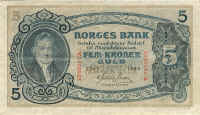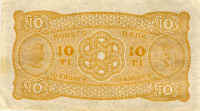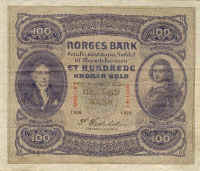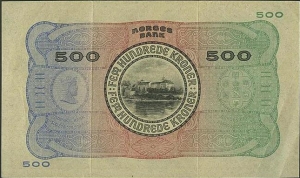|
|||||||||||
| Home | |||

Custom Search
|
|||
Find Norwegian banknotes and coins on eBay
2nd issue
The second issue was issued from 1901 to 1945, without any major change in design.
The issue was withdrawn and demonetized in 1945, after the end of the war. The German occupying power had printed large amounts of notes to finance their activities in Norway.
The notes are very similar, all notes having a portrait of President of the Storting Christie on the left, the 10, 100 and 1000 also having a portrait of Admiral Peter Wessel Tordenskiold on the right and the 5, 50 and 500 having large numerals to the right. On the back the 5 and 10 have geometric patterns and a knot, the larger denominations historical buildings in a vignette.
 5 kroner front |
 5 kroner back |
|
Back design: to the left, the head of a viking king, to the right the arms of Norway, in the middle a geometrical design (knot) knows as a Rose of Olav. Issued 1901-1944. Commoner years start at USD 16 in Good, with strictly UNC fetching about USD 200. All notes 1914 or earlier are scarce or rare, and should be reported to the census. So are a number of year/serial letter combinatons 1916-1937, among them notably 1919 F, 1923 J, 1926 J, 1929 K and 1930 M. |
|
 10 kroner front |
 10 kroner back |
|
Back design: to the left, the head of a viking king, to the right the arms of Norway, in the middle a geometrical design (knot) knows as a Rose of Olav. Issued 1901-1944. Commoner years start at USD 10 in Good, with strictly UNC fetching about USD 125. All notes 1916 or earlier are scarce or rare, and should be reported to the census. So are a number of year/serial letter combinatons 1917-1937, among them notably 1927 M, 1930 O, 1936 W and 1937 X. |
|
 50 kroner front |
 50 kroner back |
|
Back design: The mansion at Eidsvold, where the Constitutional Assembly met and decided on the Constitution of May 17th 1814, which still is the Norwegian Constitution. Surrounding it: to the left, the head of a viking king, to the right the arms of Norway surrounded by the arms of the 6 bishoprics of Norway. Issued 1901-1945. Commoner years start at USD 60 in Good, UNC notes virtually non-existent as all notes were folded once vertically before they left Norges bank - would be about USD 1000. All notes 1932 or earlier are scarce or rare, and should be reported to the census. 1945 is extremely rare as only a few notes reached circulation. |
|

100 kroner front |

100 kroner back |
|
Back design: Håkonshallen, the old Royal Castle in Bergen, which was capital for a period during the Middle Ages. Surrounding it: to the left, the head of a viking king, to the right the arms of Norway surrounded by the arms of the 6 bishoprics of Norway. Issued 1901-1945. Commoner years start at USD 60 in Good, UNC notes virtually non-existent as all notes were folded once vertically before they left Norges bank - would be about USD 1000. Most notes 1933 or earlier, and 1934 with serial letter A, are scarce or rare, and should be reported to the census (not 1924, 1928 or 1931). 1945 is extremely rare as only a few notes reached circulation. |
|
 500 kroner 1901–1944 front
500 kroner 1901–1944 frontPicture © & courtesy of Riibe mynthandel |
 500 kroner 1901–1944 back Picture © & courtesy of Riibe mynthandel |
|
Back design: Akershus Castle, the old Castle and fort in downtowen Oslo. Surrounding it: to the left, the head of a viking king, to the right the arms of Norway surrounded by the arms of the 6 bishoprics of Norway. Issued 1901-1944. "Commoner" years start at USD 1700 in Good, UNC notes virtually non-existent as all notes were folded twice vertically before they left Norges bank - would probably be about USD 10000 or more (no UNC note listed in the catalog!). Absolutely all notes are scarce or rare, and should be reported to the census. 1944 is extremely rare as only a few notes reached circulation. |
|
 1000 kroner 1901–1943 front hole cancelled
1000 kroner 1901–1943 front hole cancelledPicture © & courtesy of Riibe mynthandel |
 1000 kroner 1901–1943 back hole cancelled Picture © & courtesy of Riibe mynthandel |
|
Back design: the Cathedral of Nidaros (Trondheim), the shrine of Norway's patron saint St. Olav who was worshipped in all Scandinavia. Surrounding it: to the left, the head of a viking king, to the right the arms of Norway surrounded by the arms of the 6 bishoprics of Norway. Issued 1901-1943. "Commoner" years start at USD 800 in Good, UNC notes virtually non-existent as all notes were folded twice vertically before they left Norges bank - would probably be about USD 5000 or more (no UNC note listed in the catalog!). Nearly all notes are scarce or rare, and should be reported to the census, with the exception of 1940 and 1942. |
|
Specimen notes
After the war, a small number of left-over notes were hole cancelled and stamped SPECIMEN, and sold to collectors. Some 150 sets were made.
|
Norge, Picture courtesy of and copyright Thomas H°iland |
 |
|
|
Norge, Picture courtesy of and copyright Thomas H°iland |
 |
|
This page was last updated on 05.02.2005.
|
© janeriks Jan Erik Frantsvåg 2001 Reg.no. NO 983 140
831
Contact me by e-mail: mn@janeriks.no

